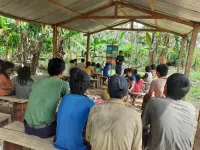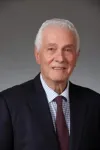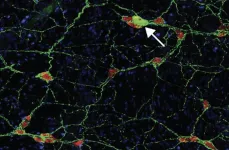(Press-News.org) (Santa Barbara, Calif.) — Indigenous peoples suffered disproportionately from the COVID-19 pandemic, experiencing a lack of sovereignty, limited infrastructure and discrimination in local healthcare systems that make them particularly vulnerable to infectious diseases. Yet little research exists to guide interventions and public health efforts tailored to remote-living Indigenous populations during pandemics.
In Bolivia, for example, a team of researchers including UC Santa Barbara’s Tom Kraft and Michael Gurven, and local collaborators, attempted to mitigate SARS-CoV-2’s impact on the Tsimané, a small-scale Indigenous society living in remote areas of the Amazon via voluntary collective isolation. The practice restricts travel to and from Indigenous territories in the hopes that remoteness, coupled with self-sufficiency in food production and a culture of resilience, would act as a buffer against disease.
A new study by the same team, now published in the journal PLOS Biology, set out to test whether voluntary collective isolation was likely to be effective at preventing rapid spread of COVID-19 transmission among Tsimané. The authors used 20-plus years of data on Tsimané population structure, movement patterns and social networks to build a computer model to assess Tsimané vulnerability to COVID-19. The simulation predicted that without any intervention, approximately four out of every five Tsimané would be infected during an outbreak, and that even the most remote communities (more than 100 km from the nearest market town) would be affected. It also revealed that without severely curtailing travel, voluntary collective isolation was likely to fail.
Sadly, the researchers confirmed their model’s predictions, showing a nearly identical rate of infection in the real world across Tsimané communities, based on serological testing of individuals after a first wave of COVID-19 infections.
“Remote-living, small-scale populations are highly vulnerable to global diseases,” said Kraft, an anthropologist from both UC Santa Barbara and the University of Utah, and the lead author of the study. “We can’t rely on remoteness and voluntary isolation alone to mitigate risks — we need to plan to direct medical resources to these communities.”
The Tsimané are one of several Indigenous tribes who hold collective title for much of the Estación Biologica del Beni and Pilón Lajas Biosphere Reserves and Indigenous Communal Lands, protected areas on the eastern flank of the Andes Mountains. They share characteristics common to many small-scale Indigenous societies, making this case study a useful reference for understanding infectious disease dynamics and public health interventions in other populations globally.
The researchers designed their model to simulate the introduction of SARS-CoV-2 from the closest urban market town, and its spread among Tsimané communities. The idea for the study began at the outbreak of the pandemic. Many of the authors have worked with the Tsimané through the Tsimané Health and Life History Project, which operates a mobile medical team that travels between villages to provide aid, while also conducting biomedical and anthropological research. Senior author Gurven, a professor of anthropology at UC Santa Barbara, co-founded the project back in 2002.
For this work amidst the pandemic, the team wanted to understand how best to direct public health messages and deploy their limited medical resources.
“At the time, there was great concern about what COVID might do if it reached the remote Amazon,” Gurven said. “So we shut down our normal operations and went into full COVID prep, hoping it wouldn’t spread. When COVID hit anyway, we then went into full surveillance mode, poised to help lessen the spread, and to help treat severe cases.”
The Tsimané are mostly self-sufficient by small-scale farming of plantains, manioc, rice and corn, and by hunting and fishing. But with better roads and outboard motors, they now come into greater contact with Bolivian merchants, colonists and others in local towns. About 18,000 Tsimané live in over 95 villages spread along rivers and logging roads — the farthest requires a multi-day boat trip to the market town. Multiple generations live together in large extended households. The close-knit community is quite social, and individuals travel frequently between villages to visit friends and family.
The authors evaluated how these characteristics would influence the extent and trajectory of disease spread, the community- and individual-level risk factors for susceptibility of infection and the effect of various intervention scenarios.
“The Beni region of Bolivia is pretty remote, and medical facilities are hard to come by,” said Dr. Daniel Eid Rodriguez, a physician and medical coordinator for the Tsimané project based in Bolivia. “Any information that can help us make informed choices to best direct limited health resources is a blessing.”
To the researchers’ surprise, the remoteness of the Tsimané communities made little difference in preventing the spread of COVID-19. Once introduced, the disease spread in a chain reaction to even the most isolated villages, as predicted by the model. The timing and magnitude of infection differed in the short term, with communities closest to market towns getting infection peaks earlier than remote villages. Yet the smaller, more isolated villages experienced the largest outbreaks proportionally, challenging the intuition that epidemics are likely to be limited in remote, low-density populations. The authors suggest that for maximum impact, public health efforts in the future should focus on dispersing limited medical and messaging resources across remote communities, rather than concentrating efforts solely on denser communities closer to urban centers.
Effectiveness of the researchers’ simulated intervention strategies was mixed. Only extreme travel restrictions substantially slowed transmission; simultaneously reducing 90% of travel to town and between villages would reduce the overall proportion of Tsimané infection by only 15%. Slowing the pace of infection, however, made almost no difference in the final outbreak size. The authors also found that if transmission rates were cut by half via vaccines or face coverings — as opposed to merely slowing infections via isolation — the cumulative infection in the populations would be reduced by 35%. Yet many local people were resistant to vaccines and the use of face coverings.
Taken together, the team’s findings suggest that efforts that only encourage face coverings or that limit contact with urban dwellers are unlikely to control the spread of infections to Indigenous communities.
END
Remoteness did little to reduce COVID-19 spread to Amazonian Tsimané
2023-08-22
ELSE PRESS RELEASES FROM THIS DATE:
SQUID increases accessibility to single-cell tumor profiling to improve treatment outcomes
2023-08-22
To improve therapies for cancer and other diseases, researchers strive to identify tissue-specific therapeutic targets and diagnostic biomarkers in every patient. Identifying specific targets and biomarkers can be achieved by analyzing the cellular composition of tumors at the single-cell level. Although tissue profiling technologies such as single-cell RNA and single-nuclei RNA sequencing provide cell-type-specific information at unprecedented resolution, their implementation has technical and financial challenges that prevent their widespread adoption in clinical settings.
In this study published in Genome Biology, researchers at Baylor College of Medicine, Ghent University ...
Drs. Ken Kellar and Ryan Hibbs win the 38th Annual Alton Ochsner Award
2023-08-22
NEW ORLEANS, LOUISIANA – Ochsner Health has announced the recipients of the 38th Annual Alton Ochsner Award Relating Smoking and Disease. They are Ken J. Kellar, Ph.D, Professor of Pharmacology, Georgetown University Medical Center, and Ryan E. Hibbs, Ph.D., Professor of Neurobiology, University of California San Diego.
This prestigious honor bestowed by Ochsner Health recognizes scientists who have made major contributions in understanding the relationship between smoking and disease, along with the development of innovative treatment modalities. The award is named in honor of Alton Ochsner, MD, the co-founder of the Ochsner ...
Optimizing tissue oxygenation in breast reduction surgery
2023-08-22
In the last few years, breast reduction procedures in the U.S. have become increasingly common. According to the American Society of Plastic Surgeons, nearly 100,000 breast reduction procedures were performed in 2020.
This procedure involves a high-tension T-Junction suture in which three incisions meet, forming the shape of a T. Larger breast reductions with longer incisions may have a higher risk of complications and wound healing problems at the T-Junction, which represent 13 to 39% of wound breakdown. It’s known that decreased blood flow to the wound, which then reduces the amount of oxygen to the area, promotes wound breakdown.
Looking to improve ...
Why childhood adversity impacts how a person’s behavior is judged
2023-08-22
It’s human nature to be judgmental. But why do we place less blame on someone, or give more praise, if we find out that person had a history of suffering in childhood? In a recent study, University of Missouri researchers discovered why someone’s childhood adversity influences how others judge their behavior.
The finding contributes to a growing body of evidence that suggests judgments of praise and blame are “asymmetrically sensitive” to certain types of information about someone’s life history, said Philip Robbins, associate professor and chair of the Department of Philosophy.
“In the case of negative or anti-social behavior, we ...
nTIDE August 2023 Deeper Dive: Employment landscape shifts to near all-time highs for people with disabilities
2023-08-22
East Hanover, August 22, 2023 — Since the COVID-19 pandemic, gains in the labor market for people with disabilities have been at near all-time highs. Expert speakers at last Friday’s nTIDE Deeper Dive Lunch & Learn Webinar provided results from an in-depth University of New Hampshire research study, which took a closer look at the unprecedented surge in employment-to-population ratio among most of the six disability subgroups identified by the U.S. Bureau of Labor Statistics (BLS). Possible driving factors behind this employment transformation were also explored.
nTIDE Deeper Dive Lunch & Learn Webinar is presented by Kessler Foundation ...
Steam condenser coating could save 460M tons of CO2 annually
2023-08-22
If coal and natural gas power generation were 2% more efficient, then, every year, there could be 460 million fewer tons of carbon dioxide released and 2 trillion fewer gallons of water used. A recent innovation to the steam cycle used in fossil fuel power generation could achieve this.
Researchers at the University of Illinois Urbana-Champaign have developed a coating for steam condensers used in fossil fuel steam-cycle generation that is made with fluorinated diamond-like carbon, or F-DLC. The researchers reported in the journal Nature Communications that this coating could boost the overall process efficiency ...
Study adds to evidence that Parkinson’s starts in the gut
2023-08-22
NEW YORK, NY--Ask any neurologist: Parkinson’s disease is a brain disorder. The conspicuous symptoms of Parkinson’s disease—uncontrollable tremors, slowed down motions, and the feeling that one’s feet are stuck to the ground—all stem from the loss of neurons in a region of the brain that helps control movement.
But many researchers believe that the neurodegenerative disorder may get started far away from the brain—in the gut—and years before the first neurological signs appear.
New findings by Columbia researchers David Sulzer, ...
Mapping methane emissions from rivers around globe reveals surprising sources
2023-08-22
Freshwater ecosystems account for half of global emissions of methane, a potent greenhouse gas that contributes to global warming. Rivers and streams, especially, are thought to emit a substantial amount of that methane, but the rates and patterns of these emissions at global scales remain largely undocumented.
An international team of researchers, including University of Wisconsin–Madison freshwater ecologists, has changed that with a new description of the global rates, patterns and drivers of methane emissions from ...
Neuroscientists create new resource to improve Alzheimer’s disease research models
2023-08-22
INDIANAPOLIS – A new study by Indiana University School of Medicine researchers uses more genetically diverse mouse models to study the accumulation and spread of abnormal tau protein deposits in the brain—a known sign of Alzheimer’s disease and several other neurodegenerative diseases. The study’s findings, recently published in the Journal of Experimental Medicine, could lead to better research models that improve understanding of how different genetic backgrounds influence neurodegenerative disease development and treatment needs.
“As ...
Glitter impairs growth of organisms with key roles in aquatic ecosystems, study shows
2023-08-22
A study conducted by researchers affiliated with the University of São Paulo (USP) in Brazil concluded that particles of glitter can hinder the growth of organisms at the base of aquatic ecosystems, such as cyanobacteria (blue-green algae), which play a key role in the biogeochemical cycles of water and soil, as well as being eaten by other organisms. An article on the study is published in the journal Aquatic Toxicology.
Ubiquitous in makeup, nail polish, holiday decorations, greeting cards, Carnival costumes and many other places, glitter sticks to skin and clothes and requires a lot of effort to remove. It is made up of microplastics, tiny particles ...





